#alphonse bertillon books
Text
Alphonse Bertillon
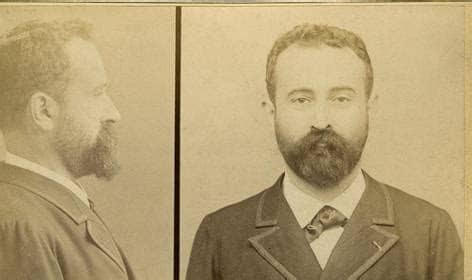
"In the late 19th century, Sherlock Holmes became the very picture of the perfect detective. Yet, even author Sir Arthur Conan Doyle declared that Holmes was only “the second-highest expert in Europe.” He was outdone by a real-life French police officer named Alphonse Bertillon."
"Alphonse Bertillon did prove more influential than Holmes when it came to solving crimes. He invented mugshots, crime scene photography, and much of forensic science itself. Indeed, more than anyone else of his time, Bertillon revolutionized criminology as we know it."
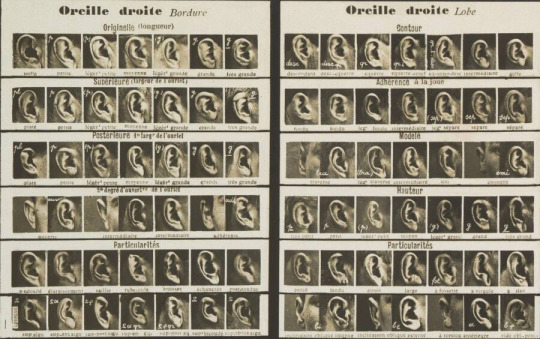
"The ears could help identify a criminal, Bertillon argued in his book. A profile mugshot helped police track down criminals by their ears."
"Bertillon’s method didn’t stop with measurements. He also decided to include a photo of each criminal to accompany their physical details. Now known as the mugshot, these images included the face and profile of each suspect."
"In the early 20th century, Bertillon’s anthropometric method declined. Police departments instead turned to fingerprinting. But the criminologist introduced two other critical tools still used in modern policing: the mugshot and crime scene photographs."
youtube
Info from the link above.
1 note
·
View note
Text
Rogue's Gallery • Donald Trump • 2023

The Fulton County Sheriff’s Office has released Donald Trump’s booking photo, or mugshot. The image is unusual for having allowed a lowered gaze and directional lighting that clearly aestheticises the portrait in a way that contravenes all of the visual conventions of police photography.
The lighting effects evidenced in the Trump picture devolve from the chiaroscuro of the 17C, and were widely adopted by the romantics so as to provide character and personality to their portraits. Lighting effects have dominated the development of fashion photography and cinema during the 20C. That's no mug-shot; it's a shameless attempt to control his image, and to project as a kind of brooding Heathcliffe...
The police mugshot was elaborated at the end of the 19C, so as to provide a visual administrative record, or true likeness. Accordingly, the picture is taken straight-up to camera and with an even lighting across the features. John Tagg (2009) has described the evolution and purpose of these images in detail.
Alphonse Bertillon, a 19C French police officer, developed a standard process for the accurate capture of a photographic likeness as part of police procedural. Bertillon also pioneered the use of photography as a way of documenting the scene-of-crime. The Bertillon system became the international standard for police photography.
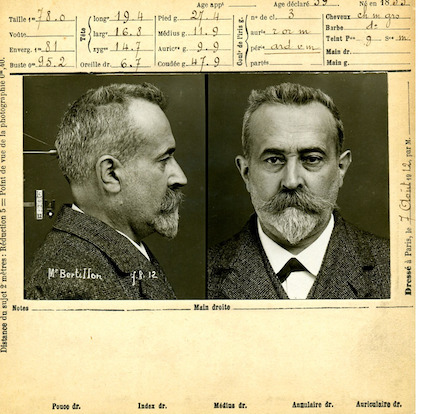
Bertillon appears as a character in the French TV detective series, Paris Police 1900, and Paris Police 1905. The crimes play out against a context of political upheaval, corruption and in relation to an increasingly scientific methodology of policing...
You can see the flat-light mugshot effect in the recent pictures of Lucy Letby.

Interestingly, a smart photo-booth would not now allow the Trump picture to be accepted as a standard passport picture.
The visual dramatisation of Trump’s booking photo may be understood as an attempt to feed the socials; but it is also a clear attempt to influence public opinion and is in contravention of the accepted norms for these kinds of administrative pictures. The complicity of law enforcement and justice officials in this process reveals a deeply-rooted systemic bias.
I recall a wonderful display by Patrick Lichfield, at the Photography Museum in Bradford, in which he described how to get a “better” passport photograph. He proposed the usual attention to height and background curtain etc, and the masking of 3/4 of the flash lights to produce directional lighting in the style of 18C aristocratic portraits.
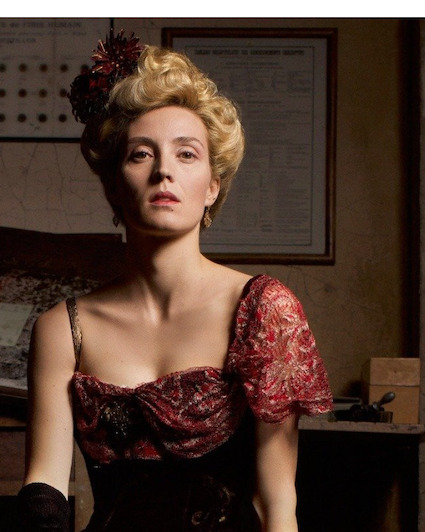
Here, for example, is a standard photo portrait in the grand style...with directional lighting and contrast. This is the actress, Evelyne Brochu, who is the star of Paris Police.
1 note
·
View note
Text
Alphonse Bertillon
Bertillon was born in the French capital of Paris. He was the younger brother of statistician and demographer Jacques Bertillon and the son of statistician Louis-Adolphe Bertillon. Alphonse Bertillon grew up in a scientific family. His...
#forensicsc
(more…)

View On WordPress
#1879 alphonse bertillon#alphonse bertillon#alphonse bertillon anthropometry#alphonse bertillon biographie#alphonse bertillon biography#alphonse bertillon books#alphonse bertillon contribution#alphonse bertillon contribution in photography#alphonse bertillon contribution to fingerprints#alphonse bertillon contribution to forensic science#alphonse bertillon contribution to forensic science date#alphonse bertillon contributions#alphonse bertillon created the first#alphonse bertillon developed a method of criminal investigation#alphonse bertillon develops system to identify people using body measurements#alphonse bertillon discover#alphonse bertillon father of#alphonse bertillon fingerprints#alphonse bertillon forensic photography#alphonse bertillon forensic science#alphonse bertillon forensics#alphonse bertillon in america#alphonse bertillon invents the modern mug shot#alphonse bertillon is known for#alphonse bertillon met museum#alphonse bertillon photography#alphonse bertillon system#alphonse bertillon table#alphonse bertillon used phtography to#alphonse bertillon was responsible for creating the first
1 note
·
View note
Photo
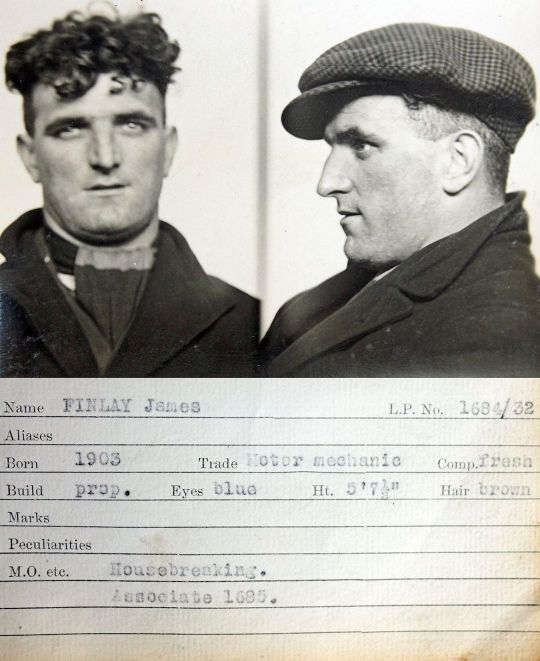
The history of the mugshot unsurprisingly started very near to the invention of the first camera in the 1885. It wasn’t only the American Wild West that prompted the need of criminals photograph. In France, police officer Alphonse Bertillon took it to the next level and added measures and details to be kept on official record in 1888. This became the norm after being arrested and booked. They were originally called “Rogues Galleries”. #mugshotmondays #mugshot #historyofthemugshot #french #rogue #lawenforcement #queenofbail #bailbonds #kidsmugshots #photography #suspects #convicts #1800s #dontgetcaughtslippin #open247 #googleme #clickoncall www.raquelqueenofbail.com https://www.instagram.com/p/B7RLmXcAvMF/?igshid=gncqflbp6z72
#mugshotmondays#mugshot#historyofthemugshot#french#rogue#lawenforcement#queenofbail#bailbonds#kidsmugshots#photography#suspects#convicts#1800s#dontgetcaughtslippin#open247#googleme#clickoncall
0 notes
Text
Artifact Series A
A Christmas Story Leg Lamp (canon)
A Dictionary of the English Language by Samuel Johnson
A.A. Milne's Honey Dipper
ABBA's Champagne Glasses
AFV Video Screen
A.J. Hackett's Bungee Cord
ATLAS Android Test Subject
Aaron's Rod
Aaron's Staff
Aaron Anderson’s Oars
Aaron Swartz's Computer Mouse
Abby Normal's Brain *
Abd Al-Rahman Al-Gillani's Walking Stick
Abebe Bikila's Jersey
Abigail Williams' Pendent
Abing's Erhu
Abraham's Sapphire
Abraham Lincoln's Top Hat *
Abraham Maslow's Hierarchy Chart
Abraham Suydam's Golden Pocketwatch
Abraham Ulrikib's Caribou Pelt
Absorbent Photo Album and Camera
Abu al-Qasim's Bellows
Abu al-Qasim's Forceps
Abu Hurairah's Tombstone
Achilles' Arrow *
Accordion from Kunstkamera
Acme Police Whistle
Ada Lovelace's Dress
Adad-nirari I’s Axe Blade
Adam Lanza's Gun
Adam Rainer's Measuring Tape
Adam Sandler's Idea Pad
Adelard of Bath’s Abacus
Adolf Eichmann's Eagle Insignia Badge
Adolf Frederick's Silver Cutlery Set
Adolf Hitler's Colored Pencils
Adolf Hitler's Microphone *
Adolf Slaby's Snuff Box
Adolphe Chaillet's "Shelby" Bulbs *
Adolphe Dugleres' Menu
Adrian Hill's Sketchpad
Aegean Sails
Aegicoros' Goblet
Aesop's Cloak
Aesop's Grapevine
Aesop's Pendant
Aesop’s Rope
Aeschylus' Turtle Shell
African Ngil Fang Mask *
African Tribal Elephant Tusk *
African Witch Doctor's Staff
Agamemnon's Mycenaean Bronze Sword
Agatha Christie's Car
Agatha Christie's Typewriter *
Agatha Christie's Wedding Ring
Agathodaemon's Natron
Agent Aden Taylor's God-Tier Clock
Agent Aden Taylor's God Tier Outfit
Aggressive Metal Lunchbox
Agnodice’s Tunic
Aguara's Carob
Ahmad Shah Durrani's Pesh-Kabz
Ahmose I’s Armband
Aileen Wuornos' Black Ledger
Aimée Crocker's Hat and Fur Stole
Air from the Great Stink of 1858
Air Raid Siren from Pearl Harbor
Air-Raid Skeet Thrower
Airbrushes from Disney Studios *
Akbar the Great's Water Container
Akira Kurosawa's Mao Hat
Akira Toriyama's Original Pen
Aki Ra’s Landmine Casings
Alain Robert’s Bag of Chalk
Albert Fish's Whip of Nails
Al Capone's Fedora
Al Capone's Machine Guns *
Al Smith's 1928 Campaign Badges
Aladdin's Lamp
Alan Hale Jr.'s Skipper Hat
Alan Seeger's Helmet
Alan Turing's Typewriter
Alan Wake's Flashlight
Alarm Clock
Albert Abrams’ Vials
Albert Anastasia's Barber Shop Chair
Albert Bandura's Bobo Doll
Albert Butz's Glasses *
Albert Camus' Coffee Cup
Albert Einstein's Bridge Device *
Albert Einstein's Chalk
Albert Einstein's Comb *
Albert Stevens’ Paintbrush
Albert Tirrell’s Razor
Alberto Burri's Sacking and Red
Albertus Magnus' Quill Pen
Alboin’s Skull Cup
Albrecht Dürer's Rhinoceros Horn
Self-portrait at 26" href="/wiki/Albrecht_D%C3%BCrer%27s_%27%27Self-portrait_at_26%27%27">Albrecht Dürer's Self-portrait at 26 *
Alchemist's Curse
Alcmaeon of Croton's Ring
Aldrich Ames' Chalk
Aldus Manutius’ Vellum
Aleijadinho’s Palanquin
Aleister Crowley's Ruby Studded Universal Hexagram Necklace *
Alejandro Jodorowsky’s Keisaku
Tetris" href="/wiki/Aleksandr_Serebrov%27s_Nintendo_Game_Boy_%26_Copy_of_%27%27Tetris%27%27">Aleksandr Serebrov's Nintendo Game Boy & Copy of Tetris
Alessandro Volta's Biscuit Bin *
Alessandro Volta's Lab Coat and Goggles *
Alethiometer
Alex Mercer's Jacket
Alex Sander's Scourge
Alexander of Abonoteichus' Grimorie
Alexander Alekhine's Chess Set *
Alexander Bain's Fax Machine
Alexander Calder's First Mobile
Alexander D'Agapeyeff's Telegraph
Alexander Fleming's Beaker
Alexander Graham Bell's Telephone Wire
Alexander the Great's Bronze Breastplate
Alexander the Great's Xyston
Alexander of Greece's Pocket Watch
Alexander Grey's Owl Pendant
Alexander Hamilton's & Aaron Burr's Dueling Pistols
Alexander Herrmann's Gold Watch
Alexander Hermann's Mustache Scissors *
Alexander Keith Jr’s Barrel
Alexander Litvinenko's Tea Pot
Alexander Morison's Top Hat
Alexander Polyhistor's Animal Fiber Sponge
Alexander Steinert's Grand Piano
Alexander von Humboldt's Fern
Alexander Wilson's Falconry Glove
Alexandre Étienne Choron’s Menu
Alexey Leonov's Near the Moon
Alexis Soyer's Cutting Board
Alexis St. Martin's Musket Powder
Al-Farabi's Shahrud
Alfred Adler’s Coat Rack
Alfred Dreyfus' Sword Hilt *
Alfred George Hinds' Prison Uniform
Alfréd Hajós' Measuring Tape
Alfred Hitchcock's Metal Pinwheel (canon)
Alfred Kinsey's Abacus
Alfred, Lord Tennyson's Bronze Statue of Chiron
Alfred's Monarch Ice Skates
Alfred Nobel's Box Detonator
Alfred Nobel's Curtains
Alfred Packer's Gold
Alfred Snoxall's Lee-Enfield Rifle
Alfred N. Stevenson's Military Helmet
Alfred Stieglitz's Tripod
Alfred Watkin’s Theodolite
Alfred Wegener's Parka
Algie the Pig
Al Herpin's Rocking Chair
Al Hirschfeld’s Chair and Lamp
Ali Asghar Borujerdi's Prayer Beads
Alice Manfield’s Trekking Pole
Alice Bailey's Necklace
Alice's Crown
Alice Stebbins Wells’ Police Badge
Alien's Device Prop
Allan Pinkerton's Briefcase
Allan W. E. Jones' Underwear
Alleyway from Kowloon Walled City
Alliance Tenna-Scope TV Signal Booster
All Hallow's Eve Pumpkin
Alphonse Bertillon's Shaving Mirror
Alphonse Cahagnet's Magnets
Alpine Brandy Rescue Cask *
Aloysius 'Alois' Alzheimer's Eye Glasses
Alpharts Tod's Hauberk
Altaïr's Hidden Blade
Aluminum Bluthner Piano *
Álvaro Obregón's Right Arm
Alvin C. Graves' Tie
Alvin C. York's .45 Colt Automatic Pistol
Alvin C. York's Medal
Alvin Straight’s Riding Lawn Mower
Alyattes of Lydia's Electrum Coins
Amanda Palmer's Ukulele
Amanda Todd's Flashcards
Amasa Coleman Lee's Porch Swing
Amaterasu's Yasakani no Magatama
Amazon Fish Tank *
The Amber Room
Amber Sphere *
Amber Spyglass
Ambrose Bierce's Skull
Ambrose Burnside's Jacket
Amelia Earhart's Goggles
Amelia Earhart's Lockheed Vega 5B
Amenemhat III’s Pyramidion
Amenemhat III's Sistrum
Amenemhat IV’s Sphinx
"American Idiot" Stage Set
Amerigo Vespucci's Armor Plate
Amityville House Windows
Ammunition from the USS Maine
Amphion's Lyre
Amulet of Hapi
Amy Lowell's Cigar
Amy Winehouse's Microphone
An Zhengwen's Brush
Anasazi Rope
Anatoly Onoprienko's Sawed off Shotgun
Anatomical Model
Anaxagoras' Krater
Anaximander's Sundial
André the Giant's Wrestling Singlet
André Citroën's Double Helical Gear
André de Toth’s 3-D Glasses
Andre Devigny's Bedding and Lantern
André Devigny Spoon
André-Marie Ampère’s Notebook
André Martinet's Phonograph
Andrea Aguyar’s Lasso
Andrea del Verrocchio's Workshop
Andreas Mihavecz’s Prison Cell
Andreas Vesalius' Watering Can
Andrew Borden's Couch
Andy Dufresne’s Rock Hammer
Andrew Jackson's Keg of Ale
Andrew Wyeth's Christina's World
Andy Kaufman's Bowl & Spoon
Andy Kaufman's Sunglasses
Andy Lambros' Fishing Pole
Andy the Clown’s Costume
Andy Warhol's Campbell's Soup Cans
Andy Warhol's Concept Dress Mannequin
Andy Warhol's Hairbrush
Andy Warhol's Marilyn Diptych
Anfo Merc's Electric Guitar and Battery Amplifier
Angela Cavallo's Car Fender
Angelo Faticoni's Chair
Angelo Moriondo’s Espresso Machine
Angelo Siciliano's Workout Trunks *
Angel Wings from the Pulse Funeral
Angkor Wat Piece of Vishnu
Ankou's Horseshoe
Angry Birdcage *
Animatronic Presidents from the "Hall of Presidents" in Walt Disney World
Anita King’s Lighter
Ann Corio's Bra
Ann Faraday's Jacket
Anna Baker's Wedding Dress
Anna Bertha Ludwig's Wedding Ring
Anna de Coligny's Crown
Anna Pavlova's Swan-Feather Fan
Annabelle Doll
Anne Boleyn's Pearl Necklace and Ornate B
Anne Bonny's Cutlass *
Anne Frank's Diary and Ribbon Bookmark
Anne Greene's Noose
Anne Sullivan’s Doll
Annette Funicello's Beach Ball *
Annie Edson Taylor's Barrel *
Annie Fox's Purple Heart
Annie Oakley’s Bonnet
Ansel Adams' Camera
Antarctic Whaling Station Camp
Anthony Bishop's Manuscript *
Anthony Salerno's Fedora *
Anthony Spilotro's Casino Tokens
Anthony Stewart/Rupert Giles' Glasses
Anti-Boarding Netting from the Mary Rose
Antique Candy Box
Antoine Lavosier's Candle
Antoine Lavosier's Microscope
Anton Aicher's Marionette Handle
Anton Chekov’s Pince-Nez's
Antoni Gaudí’s Chisel and Trencadís
Antonietta Dell'Era's Ballet Slippers
Antonio Stradivari's Violin Strings *
Antonio Vivaldi’s Aspergillum
Anton Praetorius' Hynm Book
Anubis Canopic Jar
Anubis Shrine Pyramid *
Anuket's Necklace
Aphrodite's Ankle Bracelet
Aphrodite's Girdle *
Aphrodite's Hairbrush
Apple of Discord
Apollo 11 Lunar Landing Hoax Set *
Apollo 11 Moon Rock *
Apollo 13 Command Module
Apollo 15 Geologic Hammer and Falcon Feather
Apollonius of Tyana's Amulet
Apollo of Veii's Arms
Apollo’s and Artemis’ Bows
Apollo's Sandals
Apophis Statuette
Apsley Cherry-Garrard’s Goggles
Aquilas from the Battle of Teutoburg Forest
Arachne's Loom
Arceus' Plates
Archibald McIndoe's Saline Bathtub
Archibald Spooner's Cloak
Archilochus' Aulos
Archimedes's Bathtub
Arc Light from the Iroquois Theater
Ares' Gauntlets
Aretha Franklin's Spotlight
The Argo
Ariadne's Ball of Thread
Aristotle's Lyre
Aron Ralston’s Pocketknife
Artemisia II of Caria's Chalice
Armand David's Glasses & Zucchetto
Armand Guillaumin's Soleil couchant à Ivry
Armando Socarras Ramirez's Shirt
Arne Larsson's Pacemaker
Arrow of Alan Gua
Arrow of Time
Artemis' Cloak Pin
Arthur Aitken's Pith Helmet
Arthur Aston's Wooden Leg
Arthur Blessitt’s Cross
Arthur C. Clarke's Telescope
Arthur Claude Darby's Rope
Arthur Conan Doyle's Disintegration Machine
Arthur Conan Doyle's Fairy Notebook
Arthur Conan Doyle's Pipe
Arthur Edward Waite's Tarot Deck
Arthur Evans' Magnifying Glass
Arthur Galston's Soil Knife
Arthur Rostron’s Loving Cup
Arthur Stace’s Chalk
Arthur Wellesley's Boots
Arthur Wynne's Journal
Arthur Zimmermann's Ticker-tape Machine
Artie Moore's Headphones
Artie Shaw's Clarinet *
Asclepius' Offering Bowl
Ash Williams’ Double-Barrel "Boomstick"
Ashes from the 1925 Madame Tussaud Fire
Ashley Revell's Tuxedo
Ashurbanipal's Crown
Ashoka's Hell
Ashoka's Pillars
Assorted Herbs (Parsley, Sage, Rosemary, and Thyme)
Asphyxiating Blackboard Erasers
Atalanta's Spear
Æthelred the Unready's Crown
Athena's Owl Pendant
Athena Parthenos
Athena's Aegis
Athena’s Breastplate
Athens Caryatid
Atlanta Ripper's Balaclava
Atlantean Crystal Pendant
Atlas' Globe
Atomic Bombs from The Dayton Project
Atticus Finch's Pocketwatch
Attila the Hun's Battle Helmet (canon)
Attila the Hun's Swaddling Blanket *
Audio-Healing Tuning Fork *
August Bier’s Needle
August Musger's Projector
August Natterer's Bible
Auguste Escoffier’s Tasting Spoons
Auguste Piccard's Gondola
Auguste Renoir's Young Girls at the Piano *
Auguste Rodin's Hammer and Chisel *
Auguste Rodin's Gateway to Hell
Auguste Rodin’s The Kiss
Auguste Rodin's Rasp
Augustina de Aragon's Cannon
Augustin-Jean Fresnel's Magnifying Glass *
Augustin Pyramus de Candolle’s Touch-Me-Not Plant
Augustus Saint-Gaudens’ Double Eagle Gold Coin
Aung San's Pinhole Camera
Aurora's Torch
Australian Boomerang
Automatic Trash-Disposal Waste Bin
Automatic Vaccum *
Autumn Leaves
Avatar Relics from The Last Airbender
Axe Ring
Axel Erlandson's Sycamore Seeds
Axeman of New Orleans' Phonograph
Ayrton Senna's Race Suit
Azletar (by technicality)
Aztec Bloodstone *
0 notes
Text
Historical Research of Phrenology and Anthropometry
Using physical attributes of the head and face have been used to analyze and predict attributes and behavioral patterns of men and woman before AI and sophisticated biometric technologies ever existed. Let’s take a look at Franz Joseph Gall’s Phrenological and Alphonse Bertillon’s Anthropometry and how they have both been used to systemically regulate and oppress marginalized communities.
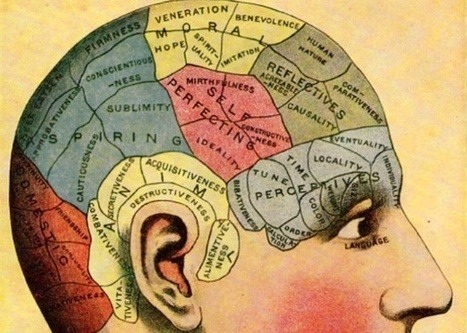
A phrenology chart showing the various divisions of the skull.
Phrenology and it’s use in politics and Biometric Criminology
To understand the current state of biometric surveillance and predictive analysis, it’s important to look at the history of similar techniques in criminology. Algorithmic facial recognition predictive analysis isn’t the first time humans have tried to come to conclusions about someone’s character, mental capacity and propensity to commit crimes by studying their facial features and head shape.
Phrenology, the study of the shape of the skull as indicative of mental faculties and traits of character was developed by German doctor Franz Joseph Gall in 1796. It’s now regarded as a pseudoscience debunked in the early 20th century, but was accepted as truth throughout the late 19th century. Gall believed that the brain was made up of 27 individual organs that determined personality, and a persons head could be measured and analyzed to reveal many personality traits and attributes. Although Gall was an expert anatomist, phrenology was used during the late 19th century to categorize human beings in racist and sexist ways.

So called “Death Masks” of criminals in Australia 1860.
As the scientific usefulness was dissemenited around the world, some . Molds were taken of criminals heads as a way of trying to preserve the details of the face and head shape in order to analyze
Cynthia S Hamilton describes how phrenology was used as a political means to justify slavery in her paper ‘Am I Not a Man and a Brother?’ Phrenology and Anti-slavery. Scientists used skull and face shapes to push ideology that caucasian males were superior to other races.

Anthropometric data sheet of Alphonse Bertillon (1853-1914), a pioneer of the Scientific Police, inventor of anthropometry, first head of the Forensic Identification Service of the Prefecture de Police in Paris (1893).
Alphonse Bertillon and the History of the Mug Shot
Alphonse Bertillon a French police officer and biometrics researcher who developed anthropometry (the scientific study of the measurements and proportions of the human body) a criminal identification system based on physical measurements. His development of the Bertillon System, wherein booked criminals had their head length, head breadth, length of middle finger, length of the left foot and length of the cubit measured and were photographed. These records were combined into a system for lay enforcement officials to access information and images quickly in an effort to identify criminals.

One of the first robust databases of biometrics was of black “Alley women” (women who were working as sex workers) in Minneapolis in the late 19th and 20th centuries. The Minneapolis Police Department followed the Bertillon System as a means to identify and document the crimes of these alley workers. The system soon became used as a tool to police and categorize these women. In Frida L. Fair’s Surveilling Social Difference: Black Women’s “Alley Work” in Industrializing Minneapolis, she argues that the Bertillon system’s attempts to categorize alley work functions as a strategy of surveillance that regulates black women’s economic and social difference. Sound familiar?
As we now know thanks in large part to Claire Garvie’s work in Perpetual Lineup, mug shot databases are being used as digital police lineups in a completely unregulated biometric data
0 notes
Text
Image taken from page 178 of 'Les Races sauvages ... Avec 115 gravures, dont huit planches hors texte'

Image taken from:
Title: "Les Races sauvages ... Avec 115 gravures, dont huit planches hors texte"
Author: BERTILLON, Alphonse.
Shelfmark: "British Library HMNTS 10007.g.27.", "British Library OC ORW.1986.a.5569"
Page: 178
Place of Publishing: Paris
Date of Publishing: 1882
Issuance: monographic
Identifier: 000299838
Explore:
Find this item in the British Library catalogue, 'Explore'.
Download the PDF for this book (volume: 0) Image found on book scan 178 (NB not necessarily a page number)
Download the OCR-derived text for this volume: (plain text) or (json)
Click here to see all the illustrations in this book and click here to browse other illustrations published in books in the same year.
Order a higher quality version from here.
from BLPromptBot http://bit.ly/2RSGXqo
0 notes
Note
Hello! I recently had a class about forensics (I'm a political science student) and we learned that it's quite a recent field, with Alphonse Bertillon etc that roughly goes back to the 19th century. Since it's not my main field, we didn't go further than that. Thus, I wondered if you knew a bit more of history about this. Are there records of forensics procedures in Ancient cultures? In non-European cultures especially? Thanks :)
Hey there @ lazypsychictheorist. ForensicScience as we know and love today is a VERY recent field of scientific inquiry,having only been established in the early 20th century. In fact, thevery first crime laboratory was established by Edmond Locard in Lyons, Francein 1910.
That is not to say that before then, criminal investigationswere a wild west of baseless queries. Besides Bertillon, some early workers inwhat is now considered to be Forensic Science are (in no particular order) SirFrancis Galton (who began the development of fingerprint examinations), SirFrancis Bacon (credited with the development of the Scientific Method), andHenry Goddard (responsible for the first forensic ballistics case). In many instances,forensic science was becoming more and more prevalent to criminalinvestigations in the early 19th century, but was not officially afield of study until Locard.
Earlier than that we must look to Ancient China. Theearliest, and most famous case that we know of comes from the 13thcentury. In this case, a farmer had been killed; There were multiple suspects allclaiming innocence. However, those in charge of determining who had done itnoticed that flies were swarming around the blade of only one of the suspects scythes.The flies were attracted to the lingering scent of blood, despite it havingbeen wiped away. The man who owned that scythe was arrested, later confessed andthis was all recorded in a book titled Xi Yuan Lu. Google can tell you moreabout that case but I’ve done my best to retell it here.
Other than that, I cannot find any other instancesof ancient forensic procedures, and none whatsoever from a non-Europeanprospective. That’s the problem with history- its written by the winners, andJulius Caesar was a dick.
42 notes
·
View notes
Text
“Scène de crime”, d’Ariane Fruit
EXPOSITION. «Scène de crime», d’Ariane Fruit
À la Galerie Document 15, à Paris.
Après avoir présenté en 2017, sous le titre «Passagers», un ensemble de dessins à la mine graphite et de gravures à l'aquatinte réalisé à partir de photographies de reflets de passagers dans les vitres de voitures du métro parisien, l’artiste graveuse Ariane Fruit vient d’exposer à Paris une toute nouvelle œuvre, 2x2,7 mètres, qui, intitulée «Scène de crime», est une sorte d’autoportrait - ce qui est une première pour cette artiste. Dans cette œuvre, on la voit en plein travail, dans l’atelier d’une douzaine de m2 qu’elle occupe depuis 2013 dans le 18ème arrondissement de Paris. < J’avais envie de conserver une image de ce lieu >, explique-t-elle lors d’une interview exclusive à «A2S, Paris».
L’œuvre, qu’elle vient tout juste d’achever, a nécessité plus d’un an de travail. En plusieurs phases successives. Première phase : du haut d’un escabeau, Ariane Fruit a d’abord photographié son atelier sous toutes les coutures - «comme si un œil regardait à travers un trou au milieu du plafond», dit-elle. En photographiant ainsi son atelier, Ariane Fruit s’est d’ailleurs inspirée de la technique de «photographie métrique» mise au point par le criminologue français Alphonse Bertillon au début du XXème siècle pour les enquêtes policières.
Seconde phase du travail : Ariane Fruit a réalisé sur ordinateur un assemblage de ces photographies qu’elle a ensuite imprimé. Etape suivante : sur une partie du sol de l’atelier, Ariane Fruit a reporté, dessiné, au feutre, ce photomontage. Et, à ce stade, elle a eu l’idée de se dessiner elle-même en train de travailler, allongée sur le sol - ce qui, au premier regard, peut donner l’impression d’une scène de crime, avec le cadavre de la victime au centre de l’image ! L’œuvre montre ainsi à la fois la silhouette d’Ariane Fruit et tous les grands et petits objets de sa vie quotidienne d’artiste.
Projet d’œuvre sur Paris la nuit
Puis, enfin, est venu, à partir de ces dessins au feutre sur le sol, un long travail - pendant huit mois ! - de gravure de cette image de l’atelier sur le revêtement de sol de celui-ci. Ce revêtement de sol, depuis bien avant l’emménagement d’Ariane Fruit dans l’atelier, était recouvert de linoleum, et c’est en creusant celui-ci, copeau par copeau, que l’artiste a gravé sur le sol l’image de son atelier, en se servant d’un outil fort ancien qu’on appelle une gouge.
Le linoleum, inventé au XIXème siècle comme revêtement de sol, a commencé à être utilisé par des artistes graveurs au début du XXème siècle. < C’est le matériau que j’utilise le plus >, confie Ariane Fruit.
Ce travail de gravure du linoleum achevé, il ne restait plus qu’à encrer cette gravure et à l’imprimer manuellement - en s’aidant d’une prothèse de hanche ! - sur des feuilles d’un papier renommé pour sa finesse et sa résistance, le papier chine. Pour reproduire la totalité de l’image de l’atelier, six feuilles de papier de 1x1 mètre furent nécessaires.
Et le résultat, c’est une impressionnante reproduction - extrêmement précise, détaillée, méticuleuse - d’un atelier d’artiste à Paris en ce début de troisième millénaire.
Ajoutons qu’Ariane Fruit envisage à présent de réaliser une œuvre sur Paris la nuit, œuvre qui, elle aussi, devrait marier photographie et gravure.
L’ARTISTE : Ariane Fruit, née à Rouen en 1975, a étudié le dessin, la photographie, l’estampe, la gravure, la photogravure et la lithographie.
POUR EN SAVOIR PLUS : https://arianefruit.com/cat-book/estampes-dessins/
0 notes
Photo
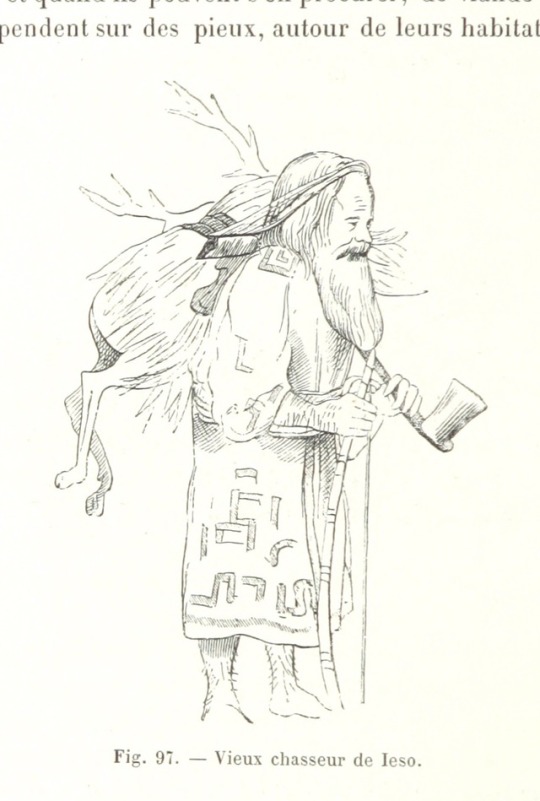
Image from 'Les Races sauvages ... Avec 115 gravures, dont huit planches hors texte', 000299838
Author: BERTILLON, Alphonse.
Page: 338
Year: 1882
Place: Paris
Publisher:
View this image on Flickr
View all the images from this book
Following the link above will take you to the British Library's integrated catalogue. You will be able to download a PDF of the book this image is taken from, as well as view the pages up close with the 'itemViewer'. Click on the 'related items' to search for the electronic version of this work.
#bldigital#bl_labs#britishlibrary#1882#similar_to_178342186342_published_date#similar_to_178342186342_slantyness#similar_to_178342186342_bubblyness_x
0 notes
Text
CONTEXTUAL STUDIES 2
As Psychology has always been an interest of mine and one of my favourite subjects after A Level, the relationship between psychology and photography has always been an interest of mine - especially in the field of mental health as this is a topic that has effected my own life greatly and I am very passionate about. From the lecture below, I decided to do my second year essay on this subject, titled ‘Discuss How the Link Between Photography and Psychiatry Came About and How This Impacted the Developments Within Psychology at the Time’. Furthermore, I have now decided to write my dissertation on the relationship between photography and mental health.
PHOTOGRAPHY, PHILOSOPHY AND PSYCHOLOGY
photography and texts can always effect a person, cant help or escape it, shows the great impact that they can have
photography has multiple histories - start thinking about all the different genres in photography
Hugh Diamond
- 1852, first photographer to photograph patients in an asylum
- showed patients pictures which showed them to be ‘mad’
- connection between mental state and physical state
- photographed in a very simple way
- used pictures of these woman as a diagnostic tool
- the photographs are truthful and an accurate representation of the person, but is this really a way to diagnose? do people believe everything they see?
- idea of the photograph as truthful
- photography as humanitarian and scientific - photography used as a tool, when you go to the hospital or the dentist, you have types of photography used on you, and you always believe it, you take it is a fact and the complete truth (eg x rays), so why does this not always apply?
- when he went into private practice, he did not photograph the rich
- ‘On the Appreciation of Photography and the Physiognomic and Mental Phenomena’ 1852-56
Guillaume-Benjamin Amand Duchenne
- believed that facial expressions reveal the soul
- basic every day interactions rely on that, can create problems if you cant read facial expressions well - photography relies on that
- triggered expressions using photography
- published findings in 1862: The Mechanism of Human Physiognomy
- book divided into scientific and aesthetic sections
- idea of the photograph as scientific evidence
- explored different characters within his work, tried to display different
- staged
- doctor within the images, trying to show authenticity with his presence and analysing of the subject
- electric shock therapy in the face, shows which muscles are moved and what controls facial impressions
- used performance sets
- taught Charcot
- reinforced social hierarchies
Jean-Martin Charcot (1825-1893)
- taught Freud
- studied hysteria within women, the idea that psychological problems would appear in woman for some kind of sexual disfunction, he had the idea that hysteria is something that is inherited
- Freud developed that the idea is the result of psychic stress
- Charcot staged pictures in various emotional states and used them as evidence of hysteria
- had women patients in an asylum which is where he staged his pictures
- gave lectures
- very questionable evidence, the aymlum had different flaws, had different wards for different level of patients, have locked wards for the most desperate cases, if the women were called up to perform at one of the Tuesday afternoon lectures but did not ‘perform’ well as to his theories, you would get benefits and be treated better, woman performed for their own well being - “every hysteric had to make a regular show of her orthodox ‘hysterical nature’ … to avoid being transferred to the severe division of the quite simple and so-called incurable ‘alienated women’.
Eugenics
- the best form of civilisation in respect to the improvement of the face … where the pride of race was encouraged, where the weak could find a welcome and a refuge in celibate monasteries or sisterhood, and lastly where the better sort of emigrants and refugees form other lands where invented and welcomed, and their descendants naturalised
1846, Agassiz said he believed that blacks and whites were different species and blacks had a different mental age, tried to prove this using images (proved nothing, just his own prejudice)
Alphonse Bertillon - Criminologist
- the Bertillon system
- ‘every measurement slowly reveals the workings of the criminal. Careful observation and patience will reveal the truth’
scientific images are often shot down, very simplistically and very factually - showing everything in the image so it can be used as the truth
2014: Zun Lee’s Father Figure, tired of stereotyping of African American males - dealers, pimps and baby daddies
- searched for his own identity
- started as a search for the ‘right kind’ of black father
- progressed from this idea and different view, going against the negative stereotype
19th Century Photography in a summary
- photography as proof
- photography as evidence
- photography as science
- photography as propaganda
- photography as art
- photography as spectacle
- photography as a self-fulfilling prophecy
0 notes
Text
Edmond Locard - A Forensic Science Pioneer
Dr. Edmond Locard (13 December 1877 – 4 May 1966) was a French criminologist and forensic science pioneer who was called "France's Sherlock Holmes."
(more…)
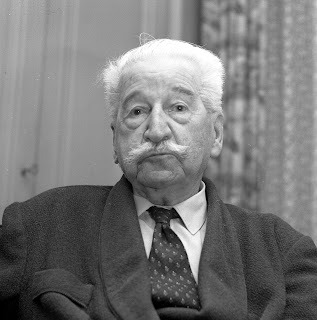
View On WordPress
#a tri fold of edmond locard#biography of edmond locard#books by edmond locard#define edmond locard#doctor edmond locard#dr edmond locard#dr edmond locard exchange principle#dr. edmond locard developed a theory known as#edmond locard#edmond locard 12 matching points#edmond locard accomplishments#edmond locard and alphonse bertillon#edmond locard background#edmond locard biography#edmond locard childhood#edmond locard contribution forensic science#edmond locard contribution to forensic science#edmond locard contribution to forensics#edmond locard crime lab#edmond locard criminal justice#edmond locard discovery#edmond locard early life#edmond locard every contract leaces a trace#edmond locard exchange principal#edmond locard family#edmond locard fingerprints#edmond locard fingerprints date#edmond locard first crime lab#edmond locard first police laboratory#edmond locard forensic pathologist
3 notes
·
View notes
Photo

"World's fairs didn't just display the pioneers of forensic science; they laid the foundation of the surveillance state. After pickpockets pilfered thousands of attendees' wallets and purses at the 1889 Exposition Universelle in Paris, Robert W. McClaughry, head of the Chicago police department, determined to avoid a similar crime wave for the 1893 World's Columbian Exposition in the Windy City. A true believer in [the methods of Alphonse Bertillon], McClaughry wielded the Frenchman's system with the blunt force of a night stick, coordinating the mass accumulation of photographs and additional identifying metrics of newly sprung convicts not just regionally but also from around the entire United States. His McGruffian take-a-bite-out-of-crime effort was considered such a triumph of the modern scientific approach to police work that it spun off into the National Bureau of Criminal Identification in 1896, which later became the FBI." #nofilter #noedit #worldsfair #book #books #reading #reader #bookworm #literature #19thcentury #flyingcarszombiedogs&robotoverlords #crime #fbi #forensicscience
#19thcentury#fbi#noedit#books#bookworm#book#crime#forensicscience#reading#flyingcarszombiedogs#literature#worldsfair#nofilter#reader
0 notes
Text
Image taken from page 313 of 'Les Races sauvages ... Avec 115 gravures, dont huit planches hors texte'
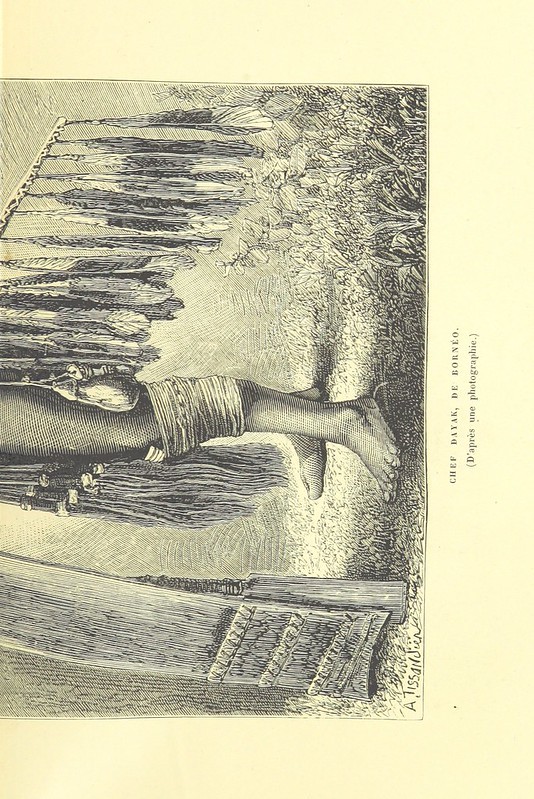
Image taken from:
Title: "Les Races sauvages ... Avec 115 gravures, dont huit planches hors texte"
Author: BERTILLON, Alphonse.
Shelfmark: "British Library HMNTS 10007.g.27.", "British Library OC ORW.1986.a.5569"
Page: 313
Place of Publishing: Paris
Date of Publishing: 1882
Issuance: monographic
Identifier: 000299838
Explore:
Find this item in the British Library catalogue, 'Explore'.
Download the PDF for this book (volume: 0) Image found on book scan 313 (NB not necessarily a page number)
Download the OCR-derived text for this volume: (plain text) or (json)
Click here to see all the illustrations in this book and click here to browse other illustrations published in books in the same year.
Order a higher quality version from here.
from BLPromptBot https://ift.tt/2No3qtQ
0 notes
Text
Image taken from page 355 of 'Les Races sauvages ... Avec 115 gravures, dont huit planches hors texte'

Image taken from:
Title: "Les Races sauvages ... Avec 115 gravures, dont huit planches hors texte"
Author: BERTILLON, Alphonse.
Shelfmark: "British Library HMNTS 10007.g.27.", "British Library OC ORW.1986.a.5569"
Page: 355
Place of Publishing: Paris
Date of Publishing: 1882
Issuance: monographic
Identifier: 000299838
Explore:
Find this item in the British Library catalogue, 'Explore'.
Download the PDF for this book (volume: 0) Image found on book scan 355 (NB not necessarily a page number)
Download the OCR-derived text for this volume: (plain text) or (json)
Click here to see all the illustrations in this book and click here to browse other illustrations published in books in the same year.
Order a higher quality version from here.
from BLPromptBot http://ift.tt/2DxZIw8
0 notes
Text
Image taken from page 232 of 'Les Races sauvages ... Avec 115 gravures, dont huit planches hors texte'
Image taken from:
Title: "Les Races sauvages ... Avec 115 gravures, dont huit planches hors texte"
Author: BERTILLON, Alphonse.
Shelfmark: "British Library HMNTS 10007.g.27.", "British Library OC ORW.1986.a.5569"
Page: 232
Place of Publishing: Paris
Date of Publishing: 1882
Issuance: monographic
Identifier: 000299838
Explore:
Find this item in the British Library catalogue, 'Explore'.
Download the PDF for this book (volume: 0) Image found on book scan 232 (NB not necessarily a page number)
Download the OCR-derived text for this volume: (plain text) or (json)
Click here to see all the illustrations in this book and click here to browse other illustrations published in books in the same year.
Order a higher quality version from here.
from BLPromptBot http://ift.tt/2CIh8DA
0 notes